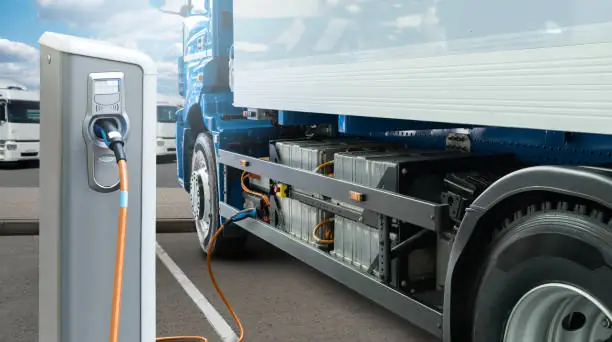Revolv’s Mythbusters Series dives into common misconceptions around electric vehicles, offering factual insights to aid fleet owners and operators and help them get the most out of the EV transition.

Electric truck batteries are charged from the charging station
The myth: EV charging and it’s infrastructure will hinder fleet transition to EV
Aside from inaccuracies around the cost of electric vehicles, there are many misconceptions about EV charging and the associated infrastructure. Today’s fleet owners and operators considering the switch to electric may have a medley of concerns:
- What if the infrastructure isn’t available to keep my fleets charged?
- What if there is not enough power to charge my fleet?
- What if my trucks lose too much charge on the road?
- How can my business be efficient with EVs?
A prevalent myth hovering over the EV ecosystem today is that there’s not enough stable charging infrastructure in place. That’s because many fleets think they will have to rely on public chargers, similar to individual electric vehicle owners. Visions of having to stop at a charging station in the middle of a long route can certainly be worrisome – but fortunately, that’s not necessary. In fact, Ford Telematics data of 2.5 million trips and 30 million miles found that the average daily range for commercial vans in the U.S. is 74 miles, well below the range of existing commercial electric vans such as the Ford E-Transit and BrightDrop ZEVO.
The fact: Understanding power capacity
Keeping a fleet of electric trucks charged can be even easier than stopping to get gas at a gas station – if done correctly. A majority of the sentiment around unstable charging solely affects consumers – so fleet managers can breathe easy. Fleet electrification is not the same as what is being said among the consumer world because fleets can take matters into their own hands to optimize and manage charging themselves.
The depot model is emerging as the leading choice for fleets looking to maintain control over their operations. With depot charging, fleets can recharge at the operator’s private hub or depot location – typically overnight while the vehicles aren’t being used and electricity is less expensive.
That brings us to the key difference between commercial and residential buildings: Houses often don’t have enough power, whereas commercial buildings do. This is because businesses need to have a lot of power for their daytime operations during their 9-5 – whether they are baking bread for wholesale or manufacturing solar panels. When the doors close each evening, this power capacity can be used for overnight charging, typically from around 5 pm to 5 am – which also happens to be when electricity costs are more cost-effective. On top of that, fleets can procure utility incentives, such as PG&E’s, for charging overnight during off-peak times.
The fact: Calming range anxiety
Revolv meets fleets where they are – including helping them find and develop a depot. So, what about the need to power up on the road? Eliminating range anxiety comes down to putting vehicles on the right routes and ensuring fleets aren’t trying to get more out of the vehicle than what’s capable. For instance, if a fleet operator knows that a vehicle can go around 100 miles before needing to recharge, targeting a route that’s 60 or 80 miles is ideal. If a fleet operator puts it on a 150-mile journey, then a driver might need to stop and use public charger, which could be broken. If a situation arises and public charging is needed, having a plan in place can keep the driver calm and in control.
But when a business has its dedicated charging infrastructure and the proper planning has been done, this translates into guaranteed uptime – delivering smooth, efficient charging that’s also cost-effective.
So, how can businesses build the infrastructure necessary to thrive?
The fact: Rightsizing your business’s infrastructure
Determining the right charging infrastructure for your fleet is both an art and a science – but mostly, it’s a lot of math. If there are 100 kW units of power in a building, a fleet could either put in two – 50 kW chargers that charge vehicles fast – or they could install ten – 10 kW chargers.
Not surprisingly, a lot of fleets opt for bigger and faster chargers. The reality is, however, that having ten slower chargers can save a lot of money and still will be sufficient to charge the vehicles overnight or when the vehicles are parked.
Having the right partner by your side
There are multiple facets to creating an optimal charging solution, but partnering with a full-service charging provider like Revolv takes away the risks and can help simplify EV fleet charging.
If a fleet has 1,000 vehicles spread over 50 sites, Revolv’s infrastructure team focuses on where it makes sense to start, looking closely at release duration, parking spots, utility bills and more – determining which ones have enough power and are good for a business’s pilots. After the fleet’s existing sites have been narrowed down, selecting the right hardware and software at those sites is also important so the maximum number of EVs can be used. It comes down to performing a detailed portfolio analysis to ensure capacity and performance – which is Revolv’s exact specialty.
If you don’t have the know-how, charging infrastructure can be one of the trickiest components of transitioning your fleet but Revolv steps in to analyze your business and manage a stable charging infrastructure solution that makes sense for you, your drivers, your customers, and everyone else so your businesses can focus on its bottom line.